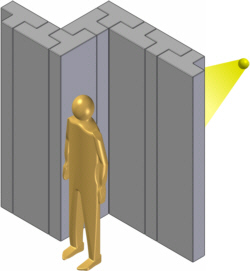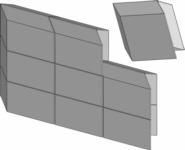Absorption is the main effect used in X-ray optics like shielding, filters, windows and beam limiting slits.
Shielding
Shielding is used to absorb as much as possible to protect the environment from radiation but also to protect measurement systems from background radiation. E.g. for persons occupationally exposed to X-rays the recommended dose limit suggested by the International Commission on Radiological Protection (ICRP) is 20 mSv/year (based on ICRP 60), averaged over defined periods of five years. Two parameters determine the effectiveness of a shielding: its thickness and its attenuation length for the X-rays in question. Consequently shieldings are made of dense materials containing elements with a high atomic number like plumb or gold. Low cost shieldings use thick walls of steel. In buildings special types of concrete are used to make shielding walls.
Often the geometry or position of shielding has to be changed. In these cases absorbing stackable elements with a suitable geometry are used (Fig. 1). The geometry of the elements is chosen in a way, that the radiation is absorbed independently from its direction, thus avoiding piercing slits.
 |
 |
Fig. 1: Stackable absorbing elements: forming a concrete shielding in a synchrotron (left) and stacked 10 cm plumb tiles (right)
Windows
Most of the technical X-ray sources generate the X-rays in a vacuum chamber: in this case the X-rays have to pass a window when leaving the X-ray source. And so the spectrum and the intensity are effected by the characteristics of the window. Typical window are glass (X-ray tubes), 0.5 mm Be-foils, Kapton-, diamond- or Al-foils (synchrotrons).
Filters
X-ray filters are used to specifically influence the spectrum of a source. For example:
- In medical applications the harmful soft X-rays have to be suppressed.
- In the LIGA-process the X-ray spectrum has to be adapted to the thickness of the resist to be exposed. The dose deposited in the depth of the exposed resist will increase when the spectrum consists mainly of hard X-rays, because the soft X-rays are absorbed directly below the surface of the resist. As the deposited dose should be constant over the thickness of the exposed resist, the X-ray spectrum has to be filtered to fit to the LIGA-mask characteristics, the resist type and thickness.


